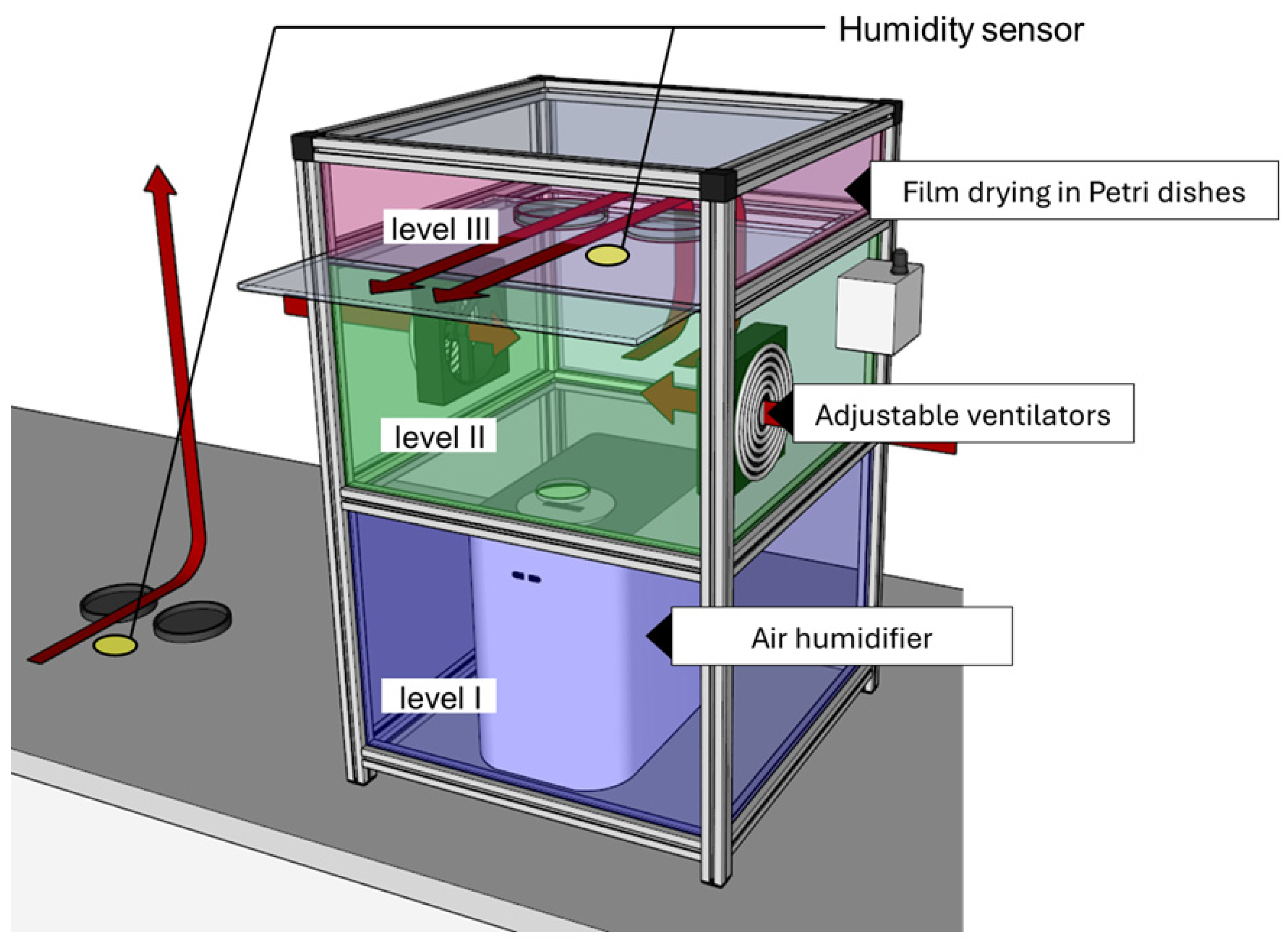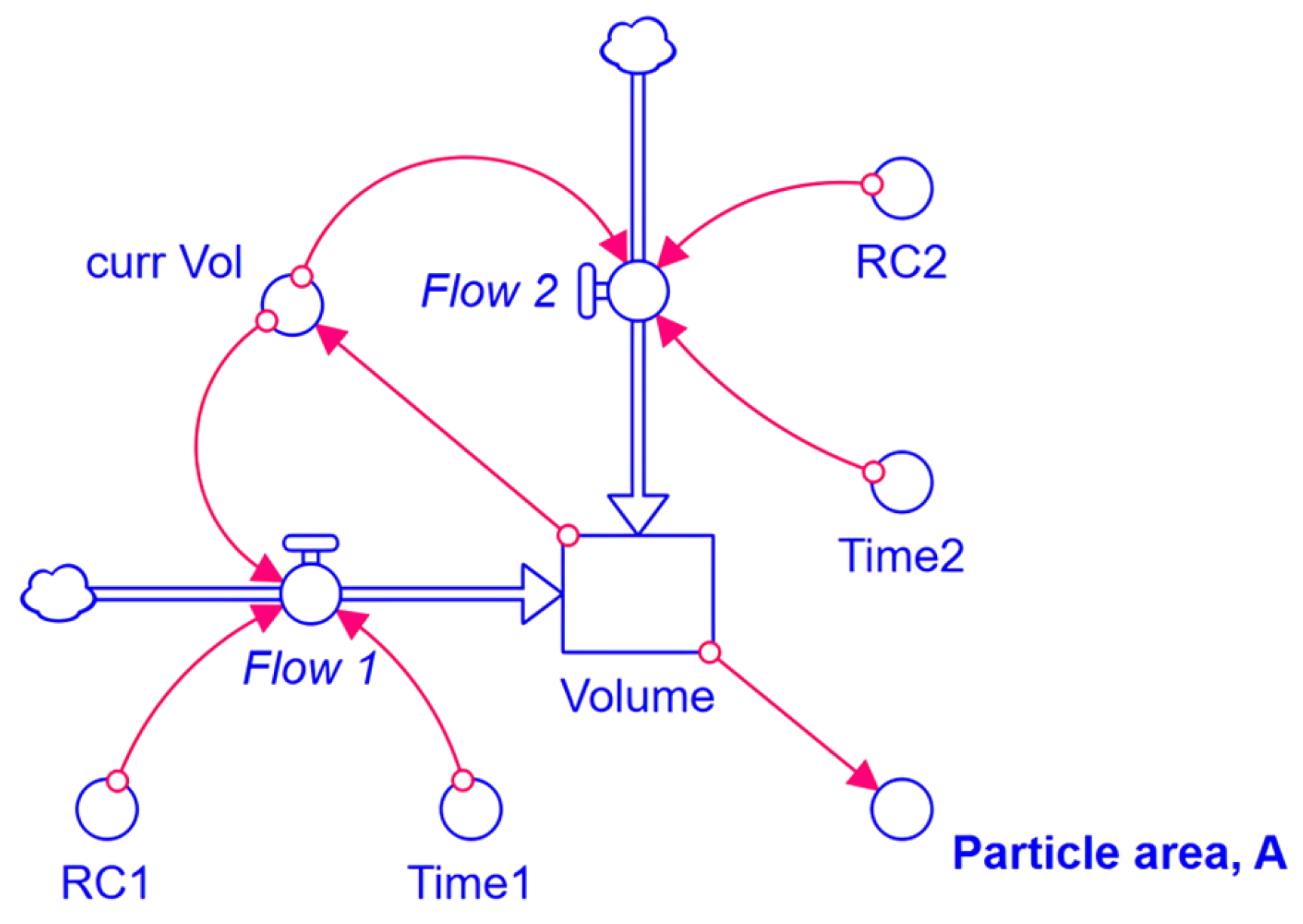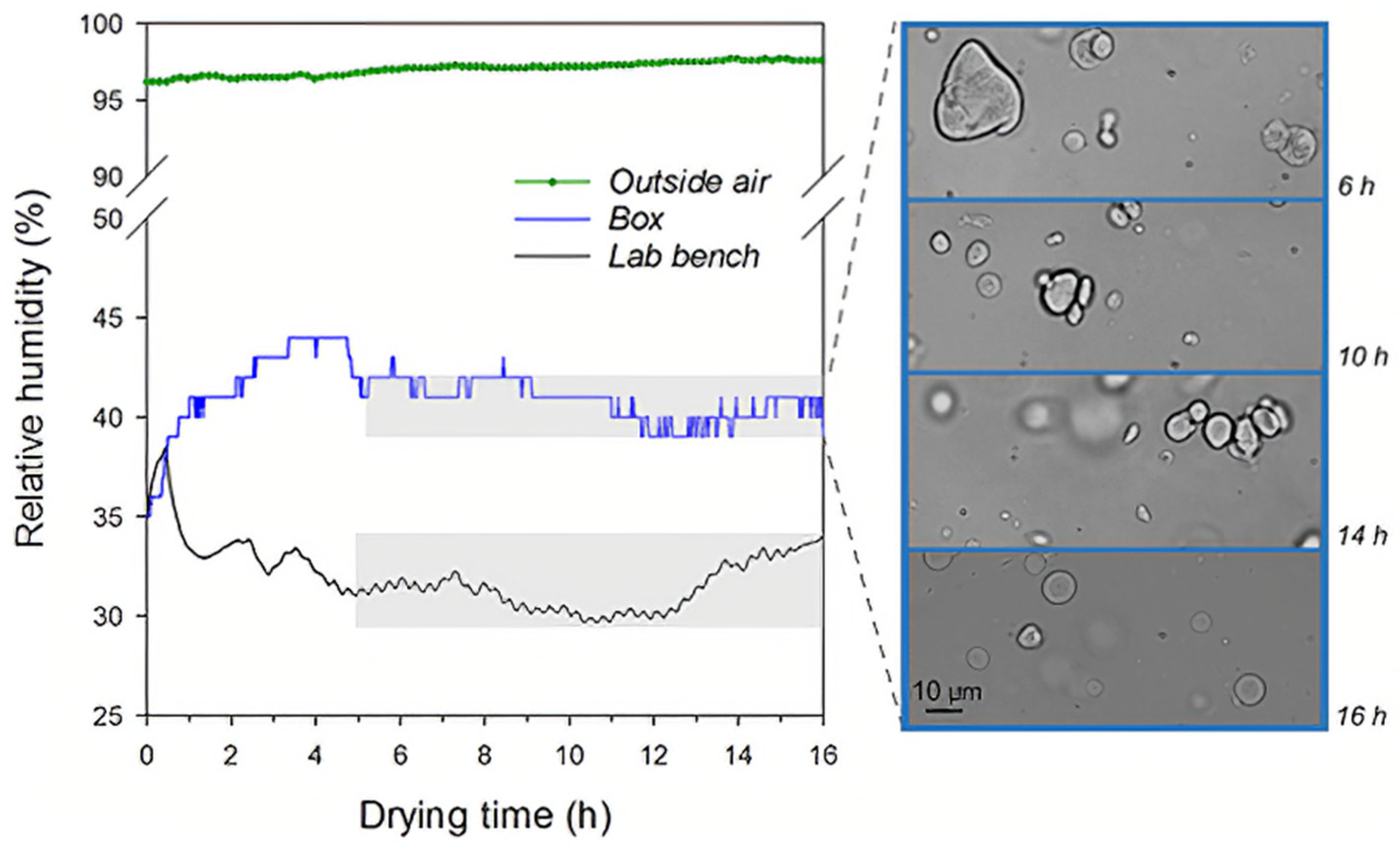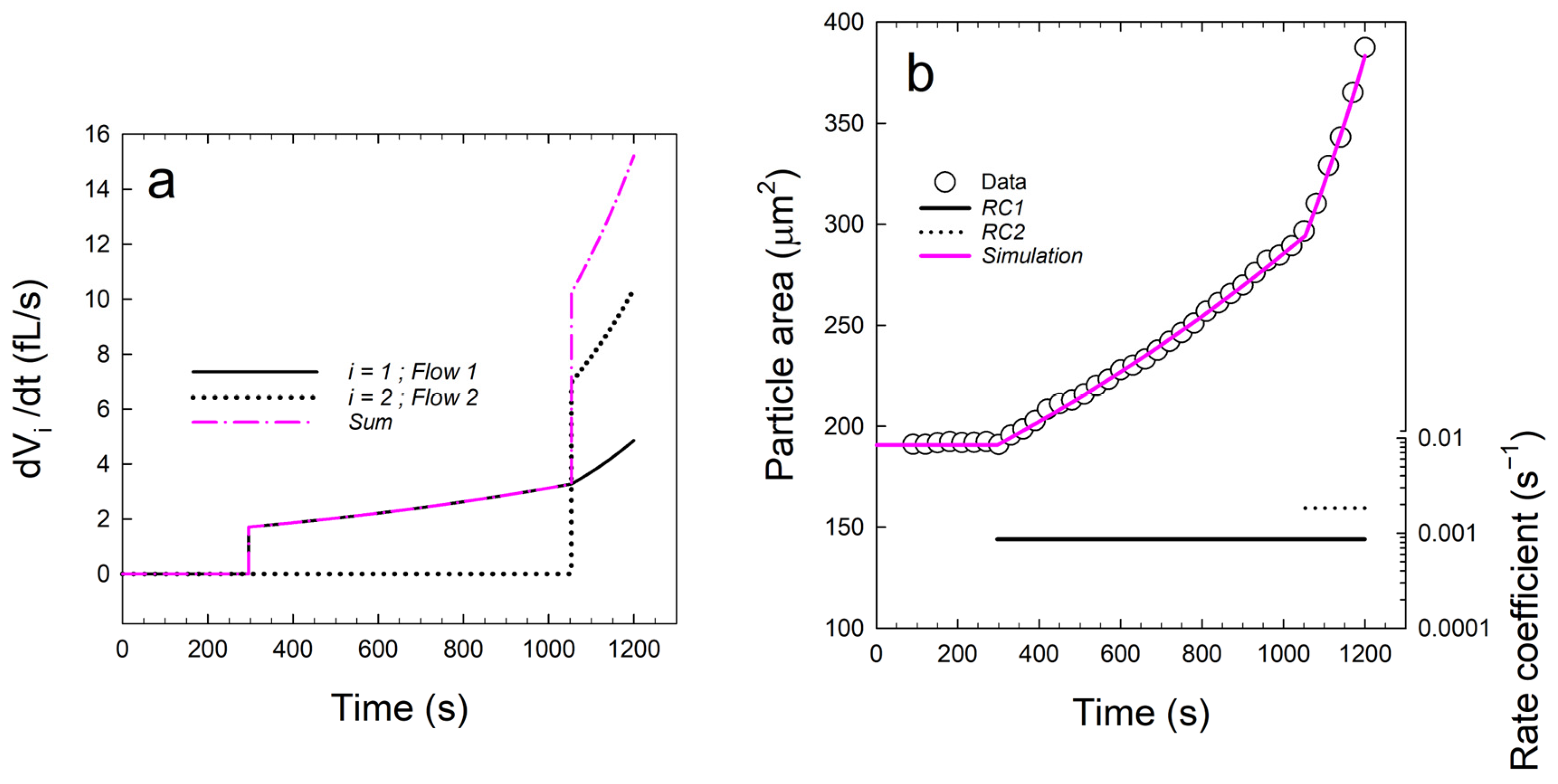Fluctuations in Humidity Influence the Structure Formation and Swelling of Casein Microparticles
Abstract
:1. Introduction
2. Materials and Methods
2.1. Materials and Preparation Process of Casein Microparticles
2.2. Swelling Experiments
2.3. System Dynamics Modeling and Simulation
3. Results and Discussion
4. Conclusions
Author Contributions
Funding
Data Availability Statement
Acknowledgments
Conflicts of Interest
References
- Holt, C.; Sawyer, L. Caseins as Rheomorphic Proteins: Interpretation of Primary and Secondary Structures of the α S1-, β-and κ-Caseins. J. Chem. Soc. Faraday Trans. 1993, 89, 2683–2692. [Google Scholar] [CrossRef]
- De Kruif, C.G. The Structure of Casein Micelles: A Review of Small-Angle Scattering Data. J. Appl. Crystallogr. 2014, 47, 1479–1489. [Google Scholar] [CrossRef]
- Nascimento, L.G.L.; Casanova, F.; Silva, N.F.N.; de Carvalho Teixeira, A.V.N.; de Carvalho, A.F. Casein-based Hydrogels: A Mini-review. Food Chem. 2020, 314, 126063. [Google Scholar] [CrossRef] [PubMed]
- De Kruif, C.G.; Huppertz, T.; Urban, V.S.; Petukhov, A.V. Casein Micelles and their Internal Structure. Adv. Colloid Interface Sci. 2012, 171, 36–52. [Google Scholar] [CrossRef]
- Hindmarsh, J.P.; Watkinson, P. Experimental Evidence for Previously Unclassified Calcium Phosphate Structures in the Casein Micelle. J. Dairy Sci. 2017, 100, 6938–6948. [Google Scholar] [CrossRef]
- Liu, Y.; Guo, R. PH-dependent Structures and Properties of Casein Micelles. Biophys. Chem. 2008, 136, 67–73. [Google Scholar] [CrossRef] [PubMed]
- De Kruif, C.G.; Zhulina, E.B. κ-Casein as a Polyelectrolyte Brush on the Surface of Casein Micelles. Colloids Surf. A Physicochem. Eng. Asp. 1996, 117, 151–159. [Google Scholar] [CrossRef]
- Bouchoux, A.; Gésan-Guiziou, G.; Pérez, J.; Cabane, B. How to Squeeze a Sponge: Casein Micelles under Osmotic Stress, a SAXS Study. Biophys. J. 2010, 99, 3754–3762. [Google Scholar] [CrossRef]
- Gebhardt, R.; Kulozik, U. Simulation of the Shape and Size of Casein Micelles in a Film State. Food Funct. 2014, 5, 780–785. [Google Scholar] [CrossRef] [PubMed]
- Morris, G.A.; Foster, T.J.; Harding, S.E. Further Observations on the Size, Shape, and Hydration of Casein Micelles from Novel Analytical Ultracentrifuge and Capillary Viscometry Approaches. Biomacromolecules 2000, 1, 764–767. [Google Scholar] [CrossRef]
- Huppertz, T.; Gazi, I.; Luyten, H.; Nieuwenhuijse, H.; Alting, A.; Schokker, E. Hydration of Casein Micelles and Caseinates: Implications for Casein Micelle Structure. Int. Dairy J. 2017, 74, 1–11. [Google Scholar] [CrossRef]
- Tang, C.H. Assembly of Food Proteins for Nano-encapsulation and Delivery of Nutraceuticals (a mini-review). Food Hydrocoll. 2021, 117, 106710. [Google Scholar] [CrossRef]
- Głąb, T.K.; Boratyński, J. Potential of Casein as a Carrier for Biologically Active Agents. Top. Curr. Chem. 2017, 375, 1–20. [Google Scholar] [CrossRef] [PubMed]
- Acuña-Avila, P.E.; Cortes-Camargo, S.; Jiménez-Rosales, A. Properties of Micro and Nano Casein Capsules Used to Protect the Active Components: A Review. Int. J. Food Prop. 2021, 24, 1132–1147. [Google Scholar] [CrossRef]
- Le Goff, G.C.; Srinivas, R.L.; Hill, W.A.; Doyle, P.S. Hydrogel Microparticles for Biosensing. Eur. Polym. J. 2015, 72, 386–412. [Google Scholar] [CrossRef] [PubMed]
- Milenkova, S.; Pilicheva, B.; Uzunova, Y.; Yovcheva, T.; Marudova, M. Casein Microgels as Benzydamine Hydrochloride Carriers for Prolonged Release. Materials 2022, 15, 1333. [Google Scholar] [CrossRef] [PubMed]
- Gasmi, H.; Danede, F.; Siepmann, J.; Siepmann, F. Does PLGA microparticle swelling control drug release? New insight based on single particle swelling studies. J. Control. Release 2015, 213, 120–127. [Google Scholar] [CrossRef] [PubMed]
- Zhuang, Y.; Sterr, J.; Kulozik, U.; Gebhardt, R. Application of Confocal Raman Microscopy to Investigate Casein Micro-particles in Blend Casein/pectin Films. Int. J. Biol. Macromol. 2015, 74, 44–48. [Google Scholar] [CrossRef]
- Maroziene, A.; De Kruif, C.G. Interaction of Pectin and Casein Micelles. Food Hydrocoll. 2000, 14, 391–394. [Google Scholar] [CrossRef]
- Zhang, H.; Goff, H.D.; Liu, C.; Luo, S.; Hu, X. Preparation of Liquid Yogurt in the Presence of Pectin and its Formation Mechanism. Food Chem. 2024, 452, 139473. [Google Scholar] [CrossRef]
- Schulte, J.; Stöckermann, M.; Gebhardt, R. Influence of PH on the Stability and Structure of Single Casein Microparticles. Food Hydrocoll. 2020, 105, 105741. [Google Scholar] [CrossRef]
- Bouchoux, A.; Cayemitte, P.E.; Jardin, J.; Gésan-Guiziou, G.; Cabane, B. Casein Micelle Dispersions under Osmotic Stress. Biophys. J. 2009, 96, 693–706. [Google Scholar] [CrossRef] [PubMed]
- Dahbi, L.; Alexander, M.; Trappe, V.; Dhont, J.K.G.; Schurtenberger, P. Rheology and Structural Arrest of Casein Suspensions. J. Colloid Interface Sci. 2010, 342, 564–570. [Google Scholar] [CrossRef] [PubMed]
- Baracat, M.M.; Nakagawa, A.M.; Casagrande, R.; Georgetti, S.R.; Verri, W.A.; de Freitas, O. Preparation and Characterization of Microcapsules Based on Biodegradable Polymers: Pectin/Casein Complex for Controlled Drug Release Systems. AAPS Pharmscitech 2012, 13, 364–372. [Google Scholar] [CrossRef] [PubMed]
- Vaucher, A.C.D.S.; Dias, P.C.; Coimbra, P.T.; Costa, I.D.S.M.; Marreto, R.N.; Dellamora-Ortiz, G.M.; De Freitas, O.; Ramos, M.F. Microencapsulation of Fish Oil by Casein-Pectin Complexes and Gum Arabic Microparticles: Oxidative Stabilisation. J. Microencapsul. 2019, 36, 459–473. [Google Scholar] [CrossRef]
- Heidebach, T.; Först, P.; Kulozik, U. Influence of Casein-Based Microencapsulation on Freeze-Drying and Storage of Probiotic Cells. J. Food Eng. 2010, 98, 309–316. [Google Scholar] [CrossRef]
- Würth, R.; Lonfat, J.; Kulozik, U. Gelation of Pre-renneted Milk Concentrate during Spray Drying and Rehydration for Microcapsule Formation. Food Bioprocess Technol. 2019, 12, 211–219. [Google Scholar] [CrossRef]
- Schulte, J.; Stöckermann, M.; Thill, S.; Gebhardt, R. Calcium Effect on the Swelling Behaviour and Stability of Casein Microparticles. Int. Dairy J. 2020, 105, 104692. [Google Scholar] [CrossRef]
- Asaduzzaman, M.; Gebhardt, R. Influence of Post-Treatment Temperature on the Stability and Swelling Behavior of Casein Microparticles. Macromol. Mater. Eng. 2023, 308, 2200661. [Google Scholar] [CrossRef]
- Devi, S.; Chaturvedi, M.; Fatima, S.; Priya, S. Environmental Factors Modulating Protein Conformations and their Role in Protein Aggregation Diseases. Toxicology 2022, 465, 153049. [Google Scholar] [CrossRef]
- Bonnaillie, L.M.; Zhang, H.; Akkurt, S.; Yam, K.L.; Tomasula, P.M. Casein Films: The Effects of Formulation, Environmental Conditions and the Addition of Citric Pectin on the Structure and Mechanical Properties. Polymers 2014, 6, 2018–2036. [Google Scholar] [CrossRef]
- Bonnaillie, L.M.; Tomasula, P.M. Application of Humidity-controlled Dynamic Mechanical Analysis (DMA-RH) to Moisture-sensitive Edible Casein Films for Use in Food Packaging. Polymers 2015, 7, 91–114. [Google Scholar] [CrossRef]
- Dumpler, J.; Kieferle, I.; Wohlschläger, H.; Kulozik, U. Milk Ultrafiltrate Analysis by Ion Chromatography and Calcium Activity for SMUF Preparation for Different Scientific Purposes and Prediction of its Supersaturation. Int. Dairy J. 2017, 68, 60–69. [Google Scholar] [CrossRef]
- De Kruif, C.G.; Tuinier, R. Polysaccharide Protein Interactions. Food Hydrocoll. 2001, 15, 555–563. [Google Scholar] [CrossRef]
- Schulte, J.; Pütz, T.; Gebhardt, R. Statistical Analysis of the Swelling Process of Casein Microparticles Based on Single Particle Measurements. Food Hydrocoll. Health 2021, 1, 100014. [Google Scholar] [CrossRef]
- Roche, J.; Caro, J.A.; Norberto, D.R.; Barthe, P.; Roumestand, C.; Schlessman, J.L.; Garcia, A.E.; García-Moreno, B.; Royer, C.A. Cavities Determine the Pressure Unfolding of Proteins. Proc. Natl. Acad. Sci. USA 2012, 109, 6945–6950. [Google Scholar] [CrossRef] [PubMed]
- Asaduzzaman, M.; Pütz, T.; Gebhardt, R. Citrate Effect on the Swelling Behaviour and Stability of Casein Microparticles. Sci. Rep. 2022, 12, 18401. [Google Scholar] [CrossRef] [PubMed]
- Vaia, B.; Smiddy, M.A.; Kelly, A.L.; Huppertz, T. Solvent-mediated Disruption of Bovine Casein Micelles at Alkaline PH. J. Agric. Food Chem. 2006, 54, 8288–8293. [Google Scholar] [CrossRef] [PubMed]
- Broyard, C.; Gaucheron, F. Modifications of Structures and Functions of Caseins: A Scientific and Technological Challenge. Dairy Sci. Technol. 2015, 95, 831–862. [Google Scholar] [CrossRef]
- McCarthy, N.A.; Power, O.; Wijayanti, H.B.; Kelly, P.M.; Mao, L.; Fenelon, M.A. Effects of Calcium Chelating Agents on the Solubility of Milk Protein Concentrate. Int. J. Dairy Technol. 2017, 70, 415–423. [Google Scholar] [CrossRef]
- Dalgleish, D.G. The Basis of Structure in Dairy-based Foods: Casein Micelles and their Properties. In Food Structures, Digestion and Health; Boland, M., Golding, M., Singh, H., Eds.; Elsevier: Amsterdam, The Netherlands, 2014; pp. 83–105. [Google Scholar] [CrossRef]
- Pink, D.A.; Peyronel, F.; Quinn, B.; Marangoni, A.G. Spontaneous Aggregation of Bovine Milk Casein Micelles: Ultra-small Angle X-ray Scattering and Mathematical Modeling. Phys. Fluids 2019, 31, 077105. [Google Scholar] [CrossRef]
- Takagi, H.; Nakano, T.; Aoki, T.; Tanimoto, M. A SAXS and USAXS Study of the Influence of PH on the Casein Micelle Structure. Food Chem. 2024, 443, 138606. [Google Scholar] [CrossRef] [PubMed]
- Gebhardt, R.; Hohn, C.; Asaduzzaman, M. Stabilizing Interactions of Casein Microparticles after a Thermal Post-treatment. Food Chem. 2024, 450, 139369. [Google Scholar] [CrossRef] [PubMed]







| Time of Drying | Drying Method | Mean Value (%) | Standard Deviation (%) |
|---|---|---|---|
| April 2024 | Box | 40.77 | 0.96 |
| Lab bench | 31.35 | 1.18 | |
| May 2024 | Box | 59.15 | 3.74 |
| Lab bench | 49.54 | 3.85 |
Disclaimer/Publisher’s Note: The statements, opinions and data contained in all publications are solely those of the individual author(s) and contributor(s) and not of MDPI and/or the editor(s). MDPI and/or the editor(s) disclaim responsibility for any injury to people or property resulting from any ideas, methods, instructions or products referred to in the content. |
© 2024 by the authors. Licensee MDPI, Basel, Switzerland. This article is an open access article distributed under the terms and conditions of the Creative Commons Attribution (CC BY) license (https://creativecommons.org/licenses/by/4.0/).
Share and Cite
Hohn, C.; Gebhardt, R. Fluctuations in Humidity Influence the Structure Formation and Swelling of Casein Microparticles. Colloids Interfaces 2024, 8, 45. https://doi.org/10.3390/colloids8040045
Hohn C, Gebhardt R. Fluctuations in Humidity Influence the Structure Formation and Swelling of Casein Microparticles. Colloids and Interfaces. 2024; 8(4):45. https://doi.org/10.3390/colloids8040045
Chicago/Turabian StyleHohn, Calvin, and Ronald Gebhardt. 2024. "Fluctuations in Humidity Influence the Structure Formation and Swelling of Casein Microparticles" Colloids and Interfaces 8, no. 4: 45. https://doi.org/10.3390/colloids8040045








